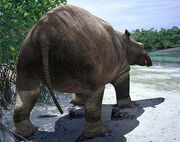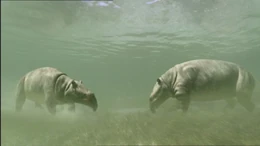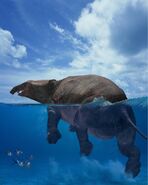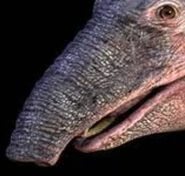Moeritherium is a prehistoric proboscidean from the Eocene of Africa featured in Walking with Beasts.
Facts[]
The Moeritherium species were pig-like animals that lived about 37-35 MYA, and resembled tapirs and pygmy hippos (they are not closely related to either of those animals, though they held a similar niche during that time period). They were smaller than modern elephants, standing only 1 meters (3 ft) high at the shoulder and were about 3 meters (10 ft) long. They are believed to have wallowed in swamps and rivers, filling the ecological niche now filled by the hippopotamus.

Moeretherium.
The shape of their teeth suggests that they ate soft water vegetation. It was related to elephants, as indicated by the primitive trunk it may have possessed. They were also amphibious like Arsinoitherium was.
The shape of animal's skull suggests that the creature did not have an elephant-like trunk, but rather a tapir-like trunk for grasping aquatic vegetation. The second incisor teeth formed small tusks, although these would have looked more like the teeth of a hippo than a modern elephant.
As amphibious mammals, these creatures were too large to be bothered by the usual predators such as crocodiles or sharks. Water wasn't usually a dangerous place for these animals, as they spent most of their days foraging in the water.
In Walking with... Series[]
Walking with Beasts[]
Whale Killer[]

Moeritherium grazing.
Initially, Moeritherium were seen underwater, in the mangrove swamps (which, ironically, would become the Sahara desert in modern times), where they fed in the coastal mangrove swamps on sea grass. A female Basilosaurus attacked a Moeritherium that had wandered from the others in search of other greenery and got it stranded on a sand bank. Luckily, the Moeritherium managed to escape all the same.
Gallery[]
|
African Elephant • Deinotherium • Moeritherium • Palaeomastodon • Woolly mammoth |




